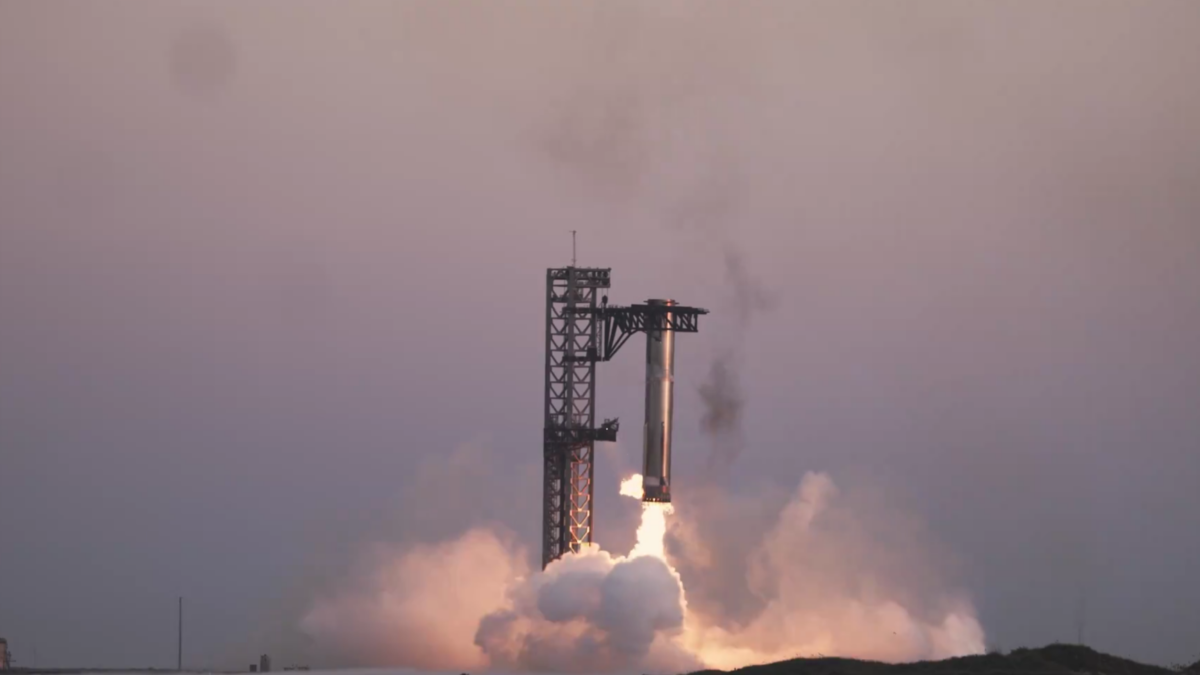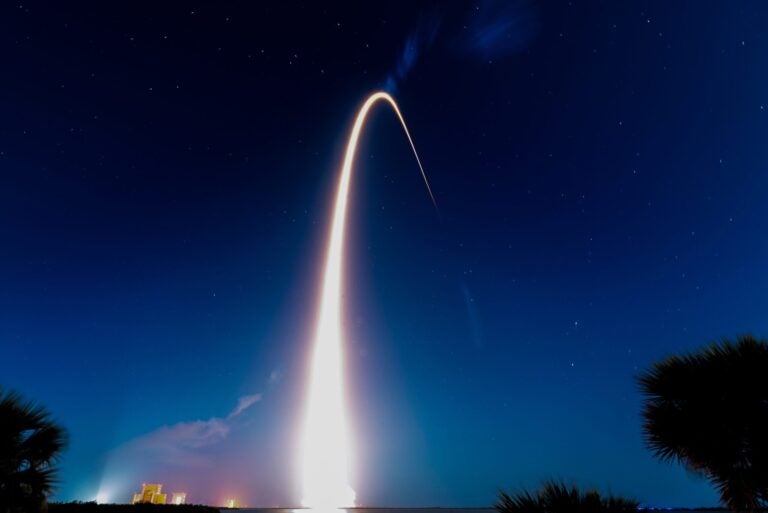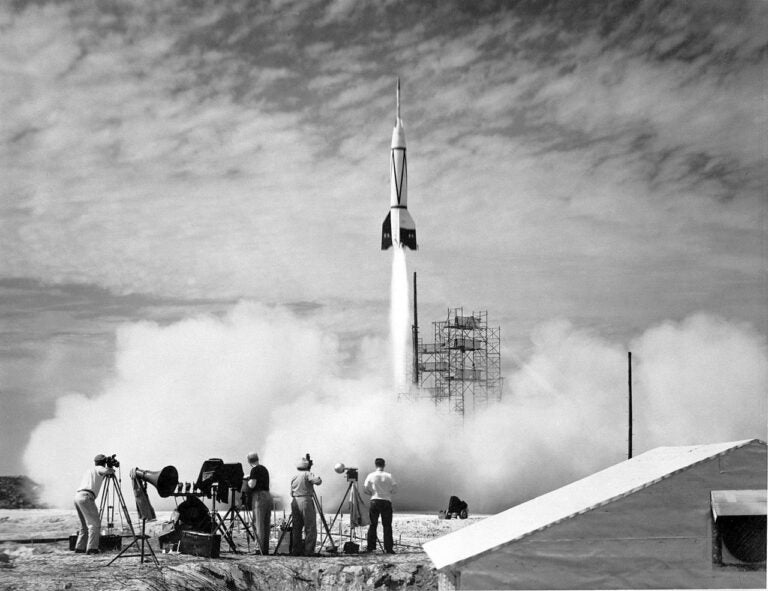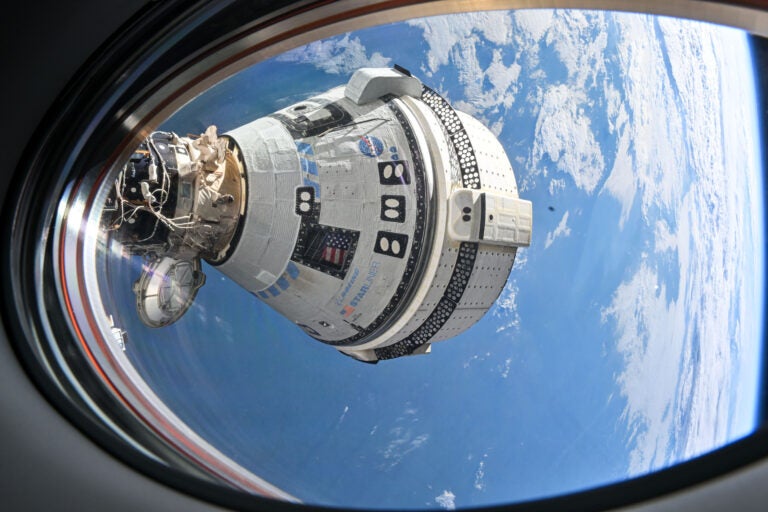
SpaceX’s Starship program—responsible for developing the largest and most powerful rocket ever flown—continues to make history.
On Sunday, Starship and the Super Heavy booster lifted off around 8:25 a.m. EST from SpaceX’s Starbase launch pad in Boca Chica, Texas, on the rocket’s fifth suborbital test flight. But rather than splash down in the Gulf of Mexico, as it did on the previous flight, Super Heavy was caught in midair by a pair of metal “chopstick” arms the company refers to as “Mechazilla.”
It is the first time such a maneuver has been successfully completed and represents the program’s most ambitious milestone to date.
“The entire SpaceX team should take pride in the engineering feat they just accomplished,” the company said in a post-launch update. “The world witnessed what the future will look like when Starship starts carrying crew and cargo to destinations on Earth, the moon, Mars and beyond.”
Built to last
As SpaceX alluded to, Starship — which stands nearly 400 feet (122 meters) tall when stacked on Super Heavy — is being designed to one day ferry humans around the solar system.
The firm is also working under a $4 billion NASA contract to develop two human landing system (HLS) variants of Starship that will return Americans to the moon for the first time since the Apollo missions. The HLS will first fly on Artemis 3, which is tentatively scheduled for September 2026 and will land NASA astronauts at the lunar south pole.
To develop such a vehicle, SpaceX will need to launch Starship hundreds of times. And to do that, both the rocket and booster will need to be turned around quickly. SpaceX therefore designed both components to be fully reusable. That makes Sunday’s mission — which returned Super Heavy to its launch pad intact — a key piece of validation.
“Congratulations to @SpaceX on its successful booster catch and fifth Starship flight test today!” said NASA Administrator Bill Nelson in a post on X. “As we prepare to go back to the Moon under Artemis, continued testing will prepare us for the bold missions that lie ahead—including to the South Pole region of the Moon and then on to Mars.”
Following liftoff, Super Heavy separated from Starship and reversed course back to Earth, descending at supersonic speed. The booster then fired a handful of engines to apply the brakes, slowing to a hover before Mechazilla snared it from the sky about seven minutes into the mission. It was a bull’s-eye landing and the first time the booster had launched and returned to the same pad. SpaceX captured the moment in real time.
“Thousands of distinct vehicle and pad criteria must be met prior to a return and catch attempt of the Super Heavy booster, which will require healthy systems on the booster and tower and a manual command from the mission’s flight director,” SpaceX said in a post on X.
Super Heavy is significantly larger than SpaceX’s ubiquitous Falcon 9 rocket, which it has successfully landed hundreds of times both on land and at sea. And because it lacks landing legs, SpaceX was forced to get creative.
The company achieved its goal remarkably quickly. The previous test of the integrated Starship and Super Heavy booster, Flight 4, was a huge step forward, as the booster splashed down “with half a centimeter accuracy,” according to Bill Gerstenmaier, vice president of build and flight reliability at SpaceX. Previous missions, however, lost the booster entirely.
According to Dan Huot, a SpaceX communications manager on Sunday’s live feed, “We’re going to start looking real soon at when we can catch a [Starship].”
Starship, meanwhile, completed its own objectives, executing hot-stage separation, ignition, and ascent to outer space. It coasted about halfway around the planet before reentering the atmosphere, flipping itself around, and making a controlled splashdown in the Indian Ocean. A camera buoy captured that moment as well.
Like during Flight 4, Super Heavy tipped over and sunk into the ocean. This time, though, SpaceX upgraded Starship’s thermal systems for reentry, where conditions are hot enough to envelop the rocket in plasma. The upgrade appeared to prevent the loss of flaps and other hardware that were jettisoned previously.
“We were not intending to recover any of the ship’s hardware, so that was the best ending that we could have hoped for,” said SpaceX engineer Kate Tice during Sunday’s live stream.
Under scrutiny
SpaceX says it intends to churn out thousands of Starships per year at its one million-square-foot Starfactory plant. But the company is frustrated by the pace of the FAA launch licensing process, even going so far as to air its grievances publicly.
The FAA took extra time to review the fifth flight’s mission profile.
“SpaceX’s current license authorizing the Starship Flight 4 launch also allows for multiple flights of the same vehicle configuration and mission profile,” an agency spokesperson told FLYING last month. “SpaceX chose to modify both for its proposed Starship Flight 5 launch which triggered a more in-depth review.”
The FAA evaluated a new splashdown site in the Gulf of Mexico as well as what it predicted would be an unusually large sonic boom during the booster landing, prompting respective 60-day consultations with the National Marine Fisheries Service and U.S. Fish and Wildlife Service. It has also proposed more than $630,000 in fines against SpaceX for allegedly violating the terms of its license during two previous missions, neither involving Starship.
According to FAA Administrator Mike Whitaker, the measures are “necessary” for safety. SpaceX takes a decidedly different perspective. It claims the agency communicated a September timeline for Flight 5 that was later revised to late November. Saturday’s approval of a launch license therefore came as a bit of a surprise.
“We continue to be stuck in a reality where it takes longer to do the government paperwork to license a rocket launch than it does to design and build the actual hardware,” SpaceX said in a September update. “This should never happen and directly threatens America’s position as the leader in space.”
SpaceX also faces scrutiny for failing to contain a liquid oxygen spill at Starbase in violation of the Clean Water Act, the EPA told FLYING last month. The company ate a $150,000 fine but denied it expels anything other than regular drinking water.
What’s next?
If it sticks to the Flight 5 mission profile for the next Starship test, SpaceX will be able to launch under its current license.
But if the firm makes significant modifications — as it is prone to do, given that each mission has been more ambitious than the last — it could become entangled in another FAA feud.
Starship’s debut crewed flight is intended to be the third mission of the Polaris Program — a series of private flights purchased from SpaceX by billionaire CEO Jared Isaacman, the first of which concluded last month. Before then, SpaceX plans to fly hundreds of missions without crew. CEO Elon Musk even said last month that the firm intends to launch routine, uncrewed Starship missions to Mars within two years.
NASA has estimated that the spacecraft will require about 15 test flights before the Starship HLS is ready to put humans back on the moon. The next step for SpaceX will be to validate orbital flight (all Starship missions so far have been suborbital) and demonstrate orbital maneuvers like propellant transfer. That’s exactly what the firm plans to do as early as next year, launching twin Starships that will mate and transfer fuel from one to the other.
Starship is loaded with about 10 million pounds of propellant, generating some 17 million pounds of thrust from its 13 Raptor engines. It boasts greater fuel capacity than any modern technology. But to give it enough juice to fly to the moon and back, it will need to fuel up at an orbital propellant depot. To hit its Artemis III deadline, NASA will need Starship to complete several missions to stock up that fuel supply. Officials are contemplating alternative mission profiles in case there isn’t enough time..
“The pacing item is the rate at which SpaceX can launch the systems that can fuel the depot,” said Lori Glaze, acting deputy associate administrator of NASA’s exploration directorate, earlier this month.
In furtherance of that objective, SpaceX is developing a second launch pad at Starbase. The company also seeks to launch and recover rockets from Launch Complex 39A at Kennedy Space Center in Florida, which could increase Starship’s cadence.
Editor’s note: This article originally appeared on FLYING.









